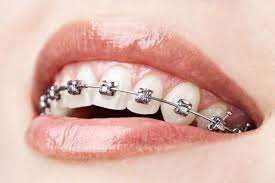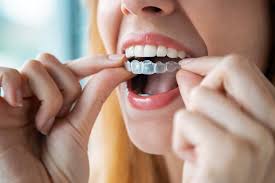Fixed Braces and Invisible Aligner

In Orthodontics, teeth are aligned for best comatic and function. Diagnosis and treatment plaining is made from history, examination of patient face, jaw and teeth and from dental cast(mode) and radiograph analysis. After individualized treatment plaining, fixed braces (metal or ceramic) are placed.
These braces are tightened by different NITI and SS wires at various stages. Patient have to visit after 4 to 6 weeks to get activation. Average treatment duration is 1.5 year (varies 6 months to 2.5year) depending upon severity of malocclusion and patient age.
What is the Ideal Age for Fixed Braces?
Ideal age for orthodontics treatment is 10 to 14 years because at this stage jaw growth modification and palatal expansion can be done and teeth move easily due to elastic nature of bone. However, braces can be placed after that age.
What is an Invisible Aligner?
In some cases, orthodontic invisible aligners in the form of transparent tray are possible. These are removable and can be removed during eating and brushing etc. These aligners have to wear 22 hours daily so need patient compliance for long term success.

Step for Clear Aligner:
- Step 1: Patient evaluation and record keeping. Patient photograph, radiograph like OPG and dental model made from dental impression are sent to Invisalign.
- Step 2: 3D Image Technology is used to create individualized custom trays. Around 10 to 20 trays are constructed by 3D Technology in sequence.
- Step 3: Patient receive aligner and clear instructions how to wear it. One aligner has to wear 2 to 3 weeks before shifted to next aligner. When aligner placed initially it is tightly fitted, it becomes loose fitted after 2 to 3 week and it’s time to shift new one.
- STEP 4: Patient visits regularly every 6 to 8 weeks to see progress of treatment. Your treatment ends when you wear last set of retainers. After completion of treatment, you have to wear retainer aligner for few months to keep teeth in desired position and prevent relapse.
Advantages of Aligners:
- Aligners are clear invisible so barely noticeable. Tradition brackets even ceramic brackets are visible.
- Comfortable: These aligners are custom fitted, flexible and user friendly.
- Excellent oral hygienic because aligners can be removed during brushing and eating.
- Excellent result.
However, need patient compliance to wear aligner 22 hours a day. Aligners are little expensive than tradition brackets. Aligners are not suitable in severe orthodontics cases so have not totally replace fixed braces.
Duration of Treatment:
Average duration for orthodontics treatment is ranges from 9 months to 2.5 year. Severity of occlusion disturbance, patient age, patient compliance, expertise of dentist and quality of fixed appliance used are main factors responsible for duration of treatment. After orthodontics, patient have to wear retainer for few months to prevent relapse.
Are Fixed Braces painful?
Fixed braces are a pain free procedure. Initially Patient feels something different (new)in oral cavity. But within few days, patient gets used to it and it feels normal. After one month, patient visits dentist for activation of fixed braces. After activation, little pressure is felt on teeth for 2 to 3 days.
What is Mechanism of Fixed Braces:
Fixed Braces work by creating pressure (tension) on teeth through wires which bring the teeth to desired aesthetic pleasing position. Activation of braces done by changing ligature or wire upgraded to thicker strong wire every month to create desired pressure.
Precautions During Fixed Braces:
Fixed Braces can compromise oral hygienic so food debris, plaque can accumulate on teeth resulting in caries and gum disease. Following precaution are mandatory:
- Excellent oral hygienic
- Brushing with fluoride and calcium containing toothpaste.
- Diet modification with reducing sugar frequency and sticky food.
- Cutting hard food like apple into small pieces before eating.
Fluoride varnish is applied at start of procedure and every 4 to 6 months to prevent decay.

